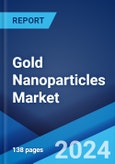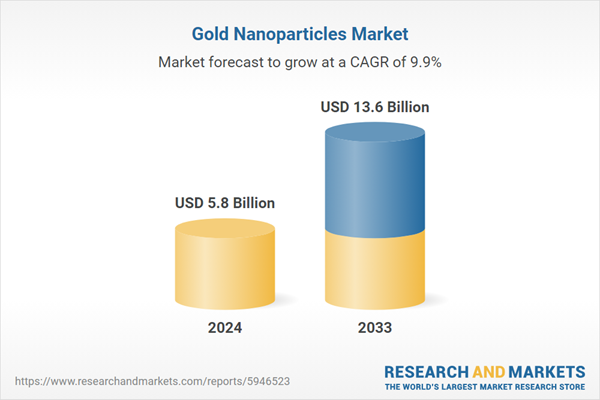The global gold nanoparticles market size reached USD 5.8 Billion in 2024. Looking forward, the market is forecast to reach USD 13.6 Billion by 2033, exhibiting a growth rate (CAGR) of 10.1% during 2025-2033. Numerous advancements in the medical industry, along with the introduction of injectable plant plastids, are primarily stimulating the market growth.
Gold nanoparticles, represented as AuNPs, are gold particles with a diameter of 1 to 100 nanometers (nm). They are majorly used in biomedical and biotechnological sciences for their large surface area and bio-inertness. They also have high electron conductivity, stability and solubility. These particles are manufactured in the form of nanospheres, nanocages, nanorods, nanoshells, nanocubes and nanoclusters and find extensive application in targeted drug administration and as agents in biomolecules delivery. Gold nanoparticles are also utilized as optical imaging probes for detection of biomarkers of various diseases and in imaging procedures such as positron emission tomography (PET), computed tomography (CT), magnetic resonance imaging (MRI) and ultrasound scans.
This report provides an analysis of the key trends in each sub-segment of the global gold nanoparticles market report, along with forecasts at the global, regional and country level from 2025-2033. The report has categorized the market based on type, application and end-use industry.
What are the key regional markets?
What has been the impact of COVID-19 on the global gold nanoparticles market?
What is the breakup of the market based on the type?
What is the breakup of the market based on the application?
What is the breakup of the market based on the end-use industry?
What are the various stages in the value chain of the industry?
What are the key driving factors and challenges in the industry?
What is the structure of the global gold nanoparticles market and who are the key players?
What is the degree of competition in the industry?
Gold nanoparticles, represented as AuNPs, are gold particles with a diameter of 1 to 100 nanometers (nm). They are majorly used in biomedical and biotechnological sciences for their large surface area and bio-inertness. They also have high electron conductivity, stability and solubility. These particles are manufactured in the form of nanospheres, nanocages, nanorods, nanoshells, nanocubes and nanoclusters and find extensive application in targeted drug administration and as agents in biomolecules delivery. Gold nanoparticles are also utilized as optical imaging probes for detection of biomarkers of various diseases and in imaging procedures such as positron emission tomography (PET), computed tomography (CT), magnetic resonance imaging (MRI) and ultrasound scans.
Gold Nanoparticles Market Trends
The growing medical industry, along with the growing demand for nanotechnological medical products, represent as the key factors driving the growth of the market. Gold nanoparticles are increasingly being used in the medical industry, especially in the dental sector, for various purposes including target imaging for cancer therapy and dental filling. Furthermore, the flourishing electronics industry is also significantly contributing to the market growth as these nanoparticles are extensively utilized to produce inks used in storage devices, hard disks and microchips. They are also used in the manufacturing of thin-film transistors and photo-sensors. Additionally, the food and beverage industry widely utilize colorimetric sensors that are manufactured using these particles. These sensors assist in detecting the freshness and consumability of food products. Various technological advancements, such as the development of injectable plant plastids to enhance biosynthesis and extensive research and development (R&D), are also driving the market further.Market Segmentation
This report provides an analysis of the key trends in each sub-segment of the global gold nanoparticles market report, along with forecasts at the global, regional and country level from 2025-2033. The report has categorized the market based on type, application and end-use industry.Breakup by Type
- Water Soluble
- Oil Soluble
- Others
Breakup by Application
- Imaging
- Targeted Drug Delivery
- Sensors
- In Vitro Diagnostics
- Probes
- Catalysis
- Others
Breakup by End-Use Industry
- Electronics
- Healthcare
- Chemicals
- Others
Breakup by Region
- North America
- United States
- Canada
- Asia Pacific
- China
- Japan
- India
- South Korea
- Australia
- Indonesia
- Others
- Europe
- Germany
- France
- United Kingdom
- Italy
- Spain
- Russia
- Others
- Latin America
- Brazil
- Mexico
- Others
- Middle East and Africa
Competitive Landscape
The competitive landscape of the industry has also been examined with some of the key players being Agilent Technologies, BBI Solutions, Cline Scientific, Cytodiagnostics, Expedeon, Goldsol, Meliorum Technologies, Merck Group, Metalor Technologies International, Nanocomposix, NanoHybrids, Nanopartz, Sigma-Aldrich, Solaris Nanosciences Corporation, Tanaka Kikinzoku, etc.Key Questions Answered in This Report
How has the global gold nanoparticles market performed so far and how will it perform in the coming years?What are the key regional markets?
What has been the impact of COVID-19 on the global gold nanoparticles market?
What is the breakup of the market based on the type?
What is the breakup of the market based on the application?
What is the breakup of the market based on the end-use industry?
What are the various stages in the value chain of the industry?
What are the key driving factors and challenges in the industry?
What is the structure of the global gold nanoparticles market and who are the key players?
What is the degree of competition in the industry?
Table of Contents
1 Preface3 Executive Summary11 Value Chain Analysis13 Price Indicators
2 Scope and Methodology
4 Introduction
5 Global Gold Nanoparticles Market
6 Market Breakup by Type
7 Market Breakup by Application
8 Market Breakup by End-Use Industry
9 Market Breakup by Region
10 SWOT Analysis
12 Porters Five Forces Analysis
14 Competitive Landscape
List of Figures
List of Tables
Companies Mentioned
- Agilent Technologies
- BBI Solutions
- Cline Scientific
- Cytodiagnostics
- Expedeon
- Goldsol
- Meliorum Technologies
- Merck Group
- Metalor Technologies International
- Nanocomposix
- NanoHybrids
- Nanopartz
- Sigma-Aldrich
- Solaris Nanosciences Corporation
- Tanaka Kikinzoku
Methodology

LOADING...
Table Information
| Report Attribute | Details |
|---|---|
| No. of Pages | 148 |
| Published | February 2025 |
| Forecast Period | 2024 - 2033 |
| Estimated Market Value ( USD | $ 5.8 Billion |
| Forecasted Market Value ( USD | $ 13.6 Billion |
| Compound Annual Growth Rate | 9.9% |
| Regions Covered | Global |
| No. of Companies Mentioned | 15 |









